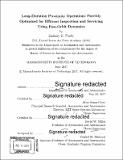Long-duration proximity operations flexibly optimized for efficient inspection and servicing using free-orbit dynamics
Author(s)
Funke, Zachary K. (Zachary Kahl)
DownloadFull printable version (26.10Mb)
Other Contributors
Massachusetts Institute of Technology. Department of Aeronautics and Astronautics.
Advisor
Alvar Saenz-Otero and David W. Miller.
Terms of use
Metadata
Show full item recordAbstract
Satellites at geosynchronous orbital altitudes are highly valuable for national defense, but are also difficult to access and monitor. Uncrewed inspection spacecraft could supervise various essential defense platforms and deter covert rendezvous by adversaries with malicious intent. 'Neighborhood watch' satellites tasked with this situational awareness mission should be designed and operated in such a way as to maximize their lifespan and efficacy. Motivated by this requirement, this thesis explores the prolonged medium- to close-range spacecraft proximity operations problem from the perspective of continuous optimal trajectory control. A numerical optimization framework is presented for developing and analyzing fuel-, energy-, and time-optimal trajectories with multiple phases using Gauss pseudospectral collocation software. Emphasis is placed on energy efficiency during inspection, for which accurate dynamical models play a critical role in formationkeeping fuel consumption. Various scenarios are analyzed for minimum-energy solutions, such as tactical phasing and insertion into periodic trajectories, avoidance of 'no-fly' zones, inclusion of coupling attitude dynamics, and operations with highly-eccentric targets. This thesis focuses primarily on proximity operations carried out in geosynchronous orbital regimes and neglects orbit perturbations, instead determining the pure cost of linearizing Keplerian gravity using the Hill-Clohessy-Wiltshire model. Error in relative position, angular rate of circumnavigation, and fuel use to enforce linearized periodic trajectories are characterized. It was determined that proximity operations utilizing low-thrust high-specific-impulse solar electric propulsion are well-suited to minimum-energy trajectory optimization with this method. While the contributed analysis tool is not suitable for on-board optimal trajectory generation, it provides a framework to perform useful pre-mission analyses.
Description
Thesis: S.M., Massachusetts Institute of Technology, Department of Aeronautics and Astronautics, 2017. Cataloged from PDF version of thesis. Includes bibliographical references (pages 211-214).
Date issued
2017Department
Massachusetts Institute of Technology. Department of Aeronautics and AstronauticsPublisher
Massachusetts Institute of Technology
Keywords
Aeronautics and Astronautics.